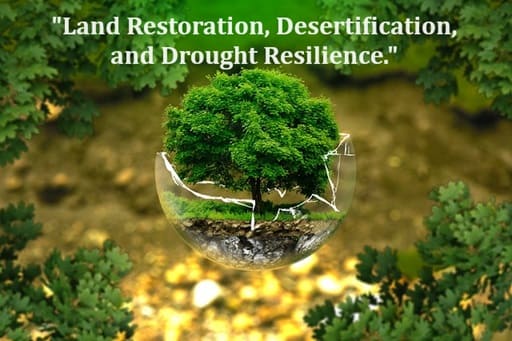Land Restoration Desertification and Drought Resilience Essay and Paragraph Writing is one of the most important essay topics on the occasion of World Environment Day 2024. Lets understand Land Restoration, Desertification, and Drought Resilience

Land Restoration Desertification and Drought Resilience
World Environment Day 2024 brings to light the pressing theme of “Land Restoration, Desertification, and Drought Resilience.” This theme underscores the critical importance of addressing land degradation, combating desertification, and enhancing resilience to droughts. Through concerted efforts and collective action, we can mitigate the adverse impacts of environmental degradation and ensure a sustainable future for generations to come.
Understanding Land Degradation:
Land degradation poses a significant threat to ecosystems, biodiversity, and human well-being. It involves the deterioration of land quality due to various factors, including deforestation, soil erosion, pollution, and unsustainable land use practices. Land degradation not only compromises the productivity of agricultural lands but also exacerbates climate change, exacerbates food insecurity, and undermines the resilience of ecosystems.
Combating Desertification:
Desertification, the process by which fertile land becomes desert, is a grave environmental challenge that affects millions of people worldwide. It is driven by factors such as deforestation, overgrazing, soil erosion, and climate change. Desertification leads to the loss of arable land, displacement of communities, and degradation of ecosystems. By implementing sustainable land management practices and restoring degraded lands, we can combat desertification and restore the productivity and resilience of affected areas.
Enhancing Drought Resilience:
Droughts are natural disasters characterized by prolonged periods of below average rainfall, leading to water scarcity, crop failures, and socioeconomic disruptions. Climate change exacerbates the frequency and severity of droughts, posing significant challenges to communities, particularly in arid and semi-arid regions. Enhancing drought resilience involves implementing measures such as water conservation, drought resistant crop cultivation, and efficient irrigation techniques. By building resilience to droughts, communities can better cope with water scarcity and maintain their livelihoods in the face of climate variability.
Promoting Land Restoration:
Land restoration is a proactive approach to reversing land degradation and restoring the health and functionality of ecosystems. It involves a range of interventions, including reforestation, afforestation, soil conservation, and sustainable land management practices. Land restoration not only improves soil fertility, water retention, and biodiversity but also enhances ecosystem services such as carbon sequestration, flood mitigation, and habitat creation. By promoting land restoration efforts, we can revitalize degraded landscapes, conserve natural resources, and mitigate the impacts of climate change.
Adopting Sustainable Land Management Practices:
Sustainable land management practices are essential for preserving land resources and promoting ecosystem resilience. These practices include agroforestry, conservation agriculture, watershed management, and reforestation. By adopting sustainable land management practices, we can improve soil health, enhance water quality, and increase agricultural productivity while reducing greenhouse gas emissions and conserving biodiversity. Sustainable land management is integral to achieving land restoration, combating desertification, and building resilience to droughts.
Empowering Communities and Stakeholders:
Addressing land degradation, desertification, and drought resilience requires the active participation and engagement of communities, stakeholders, and policymakers at all levels. Empowering communities with knowledge, resources, and decision making authority enables them to take ownership of land restoration initiatives and implement locally appropriate solutions. Building partnerships, fostering collaboration, and mobilizing support are essential for scaling up efforts to address these interconnected environmental challenges.
Conclusion
In conclusion, “Land Restoration, Desertification, and Drought Resilience” for World Environment Day 2024 serves as a call to action to protect and restore the Earth’s land resources. By combating land degradation, promoting land restoration, and enhancing resilience to droughts, we can safeguard ecosystems, protect livelihoods, and secure a sustainable future for all. Let us seize this opportunity to work together towards a world where land is healthy, productive, and resilient to the challenges of the 21st century.
